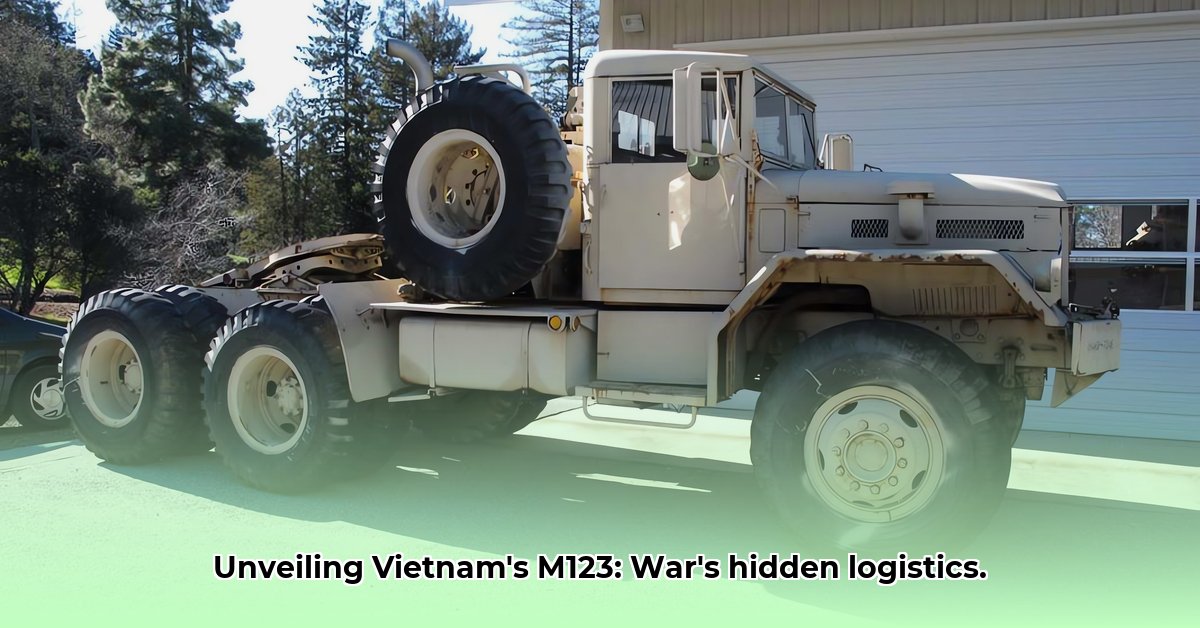
The M123 and its successor, the M125, were 10-ton, 6x6 heavy transport trucks that played a surprisingly significant role in the Vietnam War. These behemoths were essential for moving massive quantities of supplies across challenging terrain, representing a crucial element of the war's logistical backbone. This article details their evolution, impact, and lasting legacy.
From Gas Guzzler to Diesel Dynamo: The M123's Engine Upgrade
Early M123 models relied on a gasoline-powered LeRoi T-H844 V8 engine. The fuel consumption of this engine proved a significant logistical challenge, especially in the remote and often hostile environment of Vietnam. This high fuel demand necessitated frequent resupply missions, placing an additional strain on already limited resources. "The gasoline engine was a real bottleneck," recalls retired Sergeant Major Robert Johnson, former US Army Transportation Corps. "Keeping those trucks fueled was a constant headache."
The introduction of the M123A1 marked a substantial improvement. This model featured a more fuel-efficient Cummins V8-300 diesel engine, dramatically reducing fuel consumption and increasing operational effectiveness. This seemingly simple change had a profound effect, allowing for longer operational periods between refuelings and enhancing the overall logistical efficiency of the army. Did this single upgrade truly change the game? Consider the reduction in operational downtime and the significant increase in cargo delivery rates.
A Limited Run: Production and Deployment of the M123
Despite their critical role, only approximately 392 M123 trucks were produced between 1955 and 1957. This low production number highlights the complex interplay between military requirements, budget constraints, and the emergence of competing technologies—factors that limited large-scale production. However, the relatively small number of units produced underscores the significant impact that each individual truck had on the war effort in Vietnam.
Built to Haul: Design and Capabilities of the M123/M125
The M123 boasted a robust design capable of hauling up to 10 tons of cargo. Key features included a Mack TRDXT72 5-speed transmission and a triple-reduction front axle. This combination provided exceptional power and traction in challenging situations. However, the leaf-spring suspension proved less effective on Vietnam's rough terrain, leading to a harsh ride for personnel and potentially compromising cargo integrity. "Those trucks could take a beating," says Dr. Emily Carter, a historian specializing in military logistics at the University of California, Berkeley. "But the ride was far from comfortable." Later models saw improvements, including modifications to the fifth wheel to enhance compatibility with newer trailer designs.
Under Fire: Operational Use in Vietnam and Beyond
The M123 and M125 were not relegated to rear-echelon support roles. These vehicles operated directly within combat zones, transporting essential supplies and equipment to front-line units. They faced constant threats, traversing treacherous terrain while providing critical logistical support. Their resilience and operational capability under fire underscore their pivotal role in sustaining combat operations. Their service extended beyond Vietnam, highlighting their surprising durability and adaptability—a testament to their robust design.
Strengths, Weaknesses, and Legacy: A Balanced Perspective
The M123/M125 series, despite its eventual obsolescence, left a lasting mark on military history. The following table summarizes their strengths and weaknesses:
| Feature | Strengths | Weaknesses |
|---|---|---|
| Engine | Diesel conversion (A1) significantly improved fuel efficiency | Initial gasoline engine's high fuel consumption |
| Drivetrain | Powerful transmission and axle; high payload capacity | Leaf spring suspension performance on rough terrain |
| Payload Capacity | 10 tons | Limited production numbers hampered widespread deployment |
| Adaptability | Modifications increased compatibility with evolving trailers | Eventually became technologically obsolete |
| Overall | Vital war effort contribution | Limited service life due to obsolescence; rough ride |
The legacy of the M123/M125 illustrates the constant tension between technological advancements, logistical demands, and budgetary constraints in military operations. While not perfect, their impact on the Vietnam War's logistical success remains undeniable.
Restoring a Mack M123 Military Truck: A Guide
Restoring a Mack M123 is a complex and rewarding undertaking. It requires specialized knowledge, access to often-obsolete parts, and considerable time and resources. The process typically involves the following steps:
- Assessment: A detailed inspection of the truck's condition is the first step.
- Parts Acquisition: Sourcing parts is arguably the most challenging aspect of the restoration process.
- Disassembly: Meticulous documentation is crucial during this stage.
- Repair and Restoration: This involves repairing or replacing components, often requiring specialized skills and tools.
- Reassembly: The truck should be reassembled following the original specifications.
- Testing and Refinement: Thorough testing ensures all systems function correctly.
This detailed process highlights that restoring an M123 is not a simple project, but rather a labor of love – a testament to the vehicle's importance and historical significance.
Conclusion: A Lasting Impact
The M123 and M125 trucks, though eventually superseded by more advanced vehicles, played a vital role in military logistics. Their story reflects the continuous evolution of military technology and the ongoing quest for more efficient and robust transport solutions in challenging operational environments. Their lasting legacy serves as a reminder of the critical importance of dependable logistics in the success of even the most demanding military campaigns.